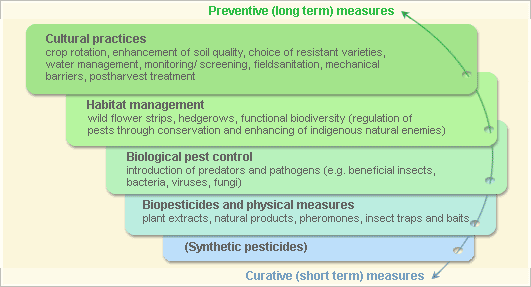Geographical Distribution in Africa
Geographical Distribution of Spider mites in Africa (red marked). Updated on 11 July 2019. Source CABI
General Information on Pest and Damage
Damage
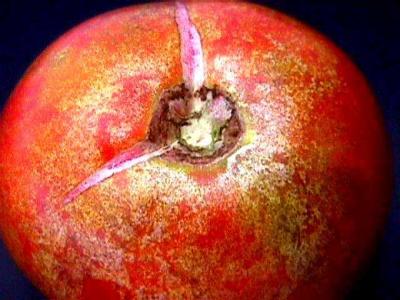 |
| Fruit damaged by spider mites. |
|
© A. M. Varela, icipe
|
Generally, spider mites prefer the undersides of leaves, but in severe infestation will occur on both leaf surfaces as well as on the stems and fruits. They suck the sap of plant tissues. Infestations are most serious in hot and dry conditions. Because they multiply very fast they are able to destroy plants within a short period of time. Spider mites spin silk threads that anchor them and their eggs to the plant. The fine web produced by spider mites protects them from some of their enemies and even from pesticide applications.
The most destructive spider mite species in East Africa is the tobacco or tomato red spider mite (Tetranychus evansi). This mite is a very serious pest in tomato crops and other members of the Solanaceae family (tomato, potato, eggplant, tobacco and wild plants and weeds like black nightshade, bitter apple and wild gooseberry). This species originates from Brazil, South America and was accidentally introduced into Southern Africa during the 80's.
Since then this spider mite has slowly been moving northwards. Nowadays it is one of the major constraints into tomato production in Kenya, Mozambique, Malawi, Namibia, Zimbabwe and Zambia. When left uncontrolled the farmer can loose his or her production within a week time.
The two spotted spider mite (Tetranychus urticae) and the carmine spider mite (Tetranychus cinnabarinus) cause yield loss on tomatoes only in exceptional cases such as: very hot and dry conditions, destruction of natural enemies, the presence of other highly infested crops in the near vicinity and insufficient water supply to the crop. For more information on this species refer to datasheet on tomato (click here).
Damage by spider mites on beans is most severe when mite feeding occurs early in the vegetative period. For more information refer to section on spider mites on datasheet of beans (click here).
Another important species is the cassava green mite (Mononychellus tanajoa), an important pest of cassava. This mite is green in colour at a young age turning yellowish as adult. It was accidentally introduced from South America and its rapid spread becoming one of the most important pests of cassava in Africa. For more information refer to datasheet on cassava (click here)
The cotton red mite (Oligonychus gossypii) is a widely distributed mite in Africa. It is commonly found on cassava, mainly during the dry season, but it is much less economically important than the cassava green mite. It also attacks cotton, citrus, peach, papaya, beans, okra, peanut, and ornamentals.
The coffee red mite (Oligonychus coffeae) may be a pest of unshaded coffee and tea in localised attacks during the dry season. They attack the upper surface of mature leaves. As a result the upper surface of fully hardened leaves turn rusty, purple or yellow brown colour. Under drought stress young leaves may also be attacked.
Host range
Spider mites have been recorded from a wide range of wild and cultivated plants - including beans, cassava, cotton, citrus, okra, tomato, papaya, potato, tobacco, strawberry various cucurbits and legumes.
Symptoms
First symptoms are usually clusters of yellow spots on the upper surface of leaves, which may also appear chlorotic. This gives the leaf a speckled or mottled appearance. Feeding by spider mites may lead to a change of leaf colour in some plants such as okra, cotton, coffee, tea and some ornamentals. Attacked leaves turn bronze, or rusty, purple or yellow brown colour. Spider mites and webbing are present on the lower leaf surface, which may appear tan or yellow and have a crusty texture.
Feeding by the cassava green mite leads to stunted and deformed cassava leaves. Severe attacks cause the terminal leaves to die and drop, and the shoot tip looks like a "candle stick".
Under severe infestations leaves redden, whither, and drop. Some spider mites (e.g. T. evansi) produce large amount of webbing. Heavy infestation will result in a fine cobwebby appearance on the leaves and the whole plant. Plants die when infestation is severe.
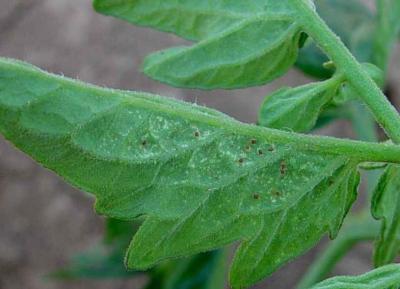 |
| Initial infestation of spider mites on tomato. Note mites seen as reddish specks on underside of a tomato leaflet. |
|
© A. M. Varela, icipe
|
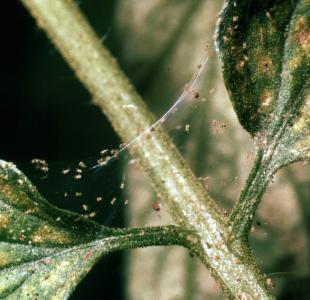 |
| Spider mites on tomato. Note the mites and their webbing visible between the leaves. |
|
© Clemson University - USDA Cooperative Extension Slide Series, Bugwood.org
|
Affected plant stages
Vegetative growing stage, flowering stage, post-harvest
Affected plant parts
Leaves, inflorescences, fruits.
Symptoms by affected plant part
Leaves: lesions, abnormal colours, abnormal leaf fall, yellowed or dead.
Inflorescences: yellow or abnormal colour, abnormal flower fall, premature fall of young fruits.
Biology and Ecology of Spider Mites
Introduction
Mites are not insects. They are related to spiders and ticks and they are very tiny (they rarely exceed a size of 0.5 mm). Spider mites are normally active within a temperature range of 16 to 37°C. They are more numerous in hot, dry weather. They are normally less numerous after rains. Wind plays an important role in the dispersal of spider mites. The lifecycle of a spider mite may take 10 to 30 days depending on temperature. It includes five stages: egg, larva (first instar) two nymphal stages and adult. A female may lay over 100 eggs during its lifespan. Spider mites spin silk threads that anchor themselves and their eggs to the plant. This silk protects them from some of their enemies and even from pesticide applications.
Description
Eggs are tiny, spherical, pale-white, and are laid on the undersides of leaves often under the webbings. They can only be seen with a magnifying lens. Eggs hatch in 4 or 5 days.
The larvae are light green or pinkish, slightly larger than the eggs and have six legs.
The nymphs look similar to the adults but are smaller. They are green or red in colour and have eight legs.
The adults are oval and have eight legs. They are very tiny (they rarely exceed a size of 0.5 mm) resembling tiny moving dots to the naked eye. The male is usually smaller than the female and have a more pointed abdomen. Spider mites are variable in colour depending on the species. Many of the species are bright red in colour; and that is reason why spider mites are sometimes referred to as red spider mites. Others are yellowish, greenish, pinkish, orange or reddish in colour. The two-spotted spider mite has a large dark blotch on each side of the body.
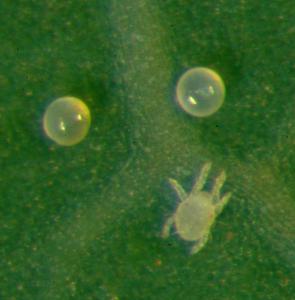 |
|
Female of the cassava green mite (Mononychellus tanajoa), real size 0.8 mm |
|
© F. Haas, icipe
|
 |
|
Eggs and larva of the cassava green mite (Mononychellus tanajoa), real size 0.2 mm |
|
© F. Haas, icipe
|
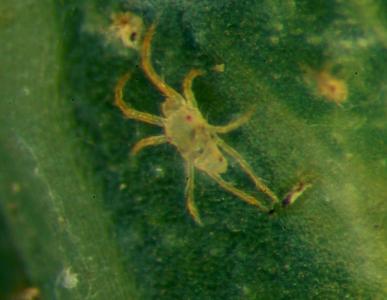 |
| Male of the cassava green mite. (Mononychellus tanajoa), real size 0.8 mm |
|
© F. Haas, icipe
|
Major species of spider mites in Africa:
- The common/two-spotted spider mite (Tetranychus urticae)
- The tobacco red spider mite (Tetranychus evansi)
- The carmine red spider mite or common red spider mite (Tetranychus cinnabarinus)
- The cassava green mite (Mononychellus tanajoa)
- The coffee red mite (Oligonychus coffeae)
- The cotton red mite (Oligonychus gossypii )
Pest and Disease Management
Pest and disease management: General illustration of the concept of Infonet-biovision
This illustration shows the methods promoted on infonet-biovision. The methods shown at the top have a long-term effect, while methods shown at the bottom have a short-term effect. In organic farming systems, methods with a long-term effect are the basis of crop production and should be with preference. On the other hand methods with a short-term effect should be used in emergencies only. On infonet we do not promote synthetic pesticides.
Cultural practices
Monitoring
Inspecting your field regularly is very important, since the population build up of the mites is very rapid. At the beginning of the infestation the distribution of mites is very patchy. Control must start early. It is very difficult to control the mite population once they are established. A recommended monitoring method for mites on tomato is:
Select randomly 20 tomato plants and access the level of damage caused by the mites of 3 leaflets/plant by using a damage leaf index ranking from 1 to 5 (1 is few yellow spots, 5 is leaf totally covered with spots, dry patches occur). Once the average damage level exceeds the first rank, control measures should start.
Less experienced farmers sometimes have difficulties with early identification of the mites, since the symptoms resemble a nutrient deficiency or plant disease. Close inspection of the underside of affected leaves shows mites as tiny moving specks (red or yellow-greenish depending on the species) and whitish particles (shed skins of mites).
Further cultural practices are:
- Site nurseries away from infested crops and avoid planting next to infested fields.
- Grow healthy crops; avoid water and nutrient stress. Apply mulch and incorporate organic matter into the soil to improve the water holding capacity and reduce evaporation.
- Keep perennial hedges such as pigeon peas, they are said to encourage predatory mites, which predate on spider mites.
- Uproot and burn infested plants. This can be successful during the early stages of infestation when the mites concentrate on a few plants.
- Keep the field free of weeds.
- Remove and burn infested crop residues immediately after harvest
- Mites favour dry and hot conditions. Influencing the microclimate by reducing the planting distance is reported to suppress spider mite populations. However, this could also enhance fungal diseases, so care should be taken.
- When moving through the crop for weeding, pruning, harvesting or any other field work, always leave the infested area until last in order to minimise the spread of mites on clothing or farm tools
Biological pest control
Natural enemies
A range of natural enemies attacks spider mites. The most important are predatory mites, predatory beetles such as small staphilinidae (Oligota spp), and ladybird beetles, lacewings, predatory thrips, anthocorid bugs (Orius spp), mirid bugs, and predatory flies such as cecydomyiid and hoverflies.
Naturally occurring predators are in most cases capable of controlling infestations of the two-spotted spider mite and the carmine red spider mite, provided natural enemies are not disturbed by the severe use of broad-spectrum pesticides - and if the crop is irrigated properly.
This is not the case for spider mites that have been accidentally introduced from other continents. Thus, few natural enemies are known to feed on the tobacco spider mite in Africa. In contrast, natural enemies keep this mite under control in his home region (Brazil). ICIPE has recently conducted experimental releases of a predatory mite (Phytoseiulus longipes) introduced from Brazil into Kenya (personal communication, Markus Knapp, icipe).
The cassava green mite has been effectively controlled by predatory mites (mainly Typhlodromalus aripo and T. manihoti) introduced from South America, the home of the cassava green mite (Yaninek and Hanna, 2003).
Several natural enemies of spider mites are commercially available worldwide. The most common is the predacious mite Phytoseiulus persimilis. This predatory mite, widely used for control of the two-spotted spider mite, is present in Kenya and it is commercially available. Suitable release rates and timings vary with the crop. In areas where the mite has been established, augmentative releases are required to maintain control. For more information on natural enemies click here.
 |
| Tetranychus predators - predatory mites (orange-red individuals)(Phytoseiulus persimilis) in a colony of the two-spotted spider mite (Tetranychus urticae). Spider mites are very tiny, they rarely exceed a size of 0.5 mm. |
|
© Warwick HRI, University of Warwick.
|
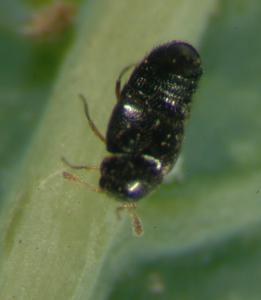 |
| Adult of the predatory beetle Oligota sp. a natural enemy of mites. |
|
© F. Haas, icipe
|
According to RealIPM newsletter of Jan 2008, the horticultural export company Oserian has now been spider mite free for 1 1/2 years using Phytoseiulud persimilis and integrated management saving large amounts on money on acaricides and getting much better quality roses. The same predatory mite is also effective for spider mites on French beans both in green house and field conditions. Available from Real IPM and Koppert(Ltd). See contacts below.
Biopesticides and physical methods
Neem
Neem products, in particular oil formulations give reasonable control of spider mites. Though neem does have some systemic effect in plants, spray it as other contact insecticides, ensuring thorough spray coverage and targeting the undersides of the leaves where spider mites tend to cluster. Neem commercial products are available in Kenya. Use as recommended. For more information on Neem click here.
Soap spray
Apply on the infested plants thoroughly, including the undersides of the leaves. Spray early in the morning or late afternoon.
Precaution:
Soap spray may injure foliage. Test these sprays on few leaves before applying to the entire field. It may take 2 days for damage symptoms to appear. For the recipe of soap spray click here.
Pyrethrum
Spray of natural commercial pyrethrum extracts such as "Flower DS®" (Kenya) control spider mites when applied on very early outbreaks (farmer experience, Kenya). Take care of beneficial insects, which are also killed by pyrethrum.
For more information on pyrethrum click here.
Flour preparations
Flour mixed in water is said to be very effective against aphids and spider mites. It should be applied in the morning taking care to spray underside of leaves. As the heat of the sun increases, the mixture dries out and the insects are left encrusted in flour, shrivel and die. The coating of flour falls off the leaves so that their ability to photosynthesise is not essentially affected (Gabriele Stoll, 1988). For information on flour preparations click here
Glues
Any water-soluble glue, particularly those obtained from plants, for example glue (starch) obtained by boiling potatoes and cassava in water has been reported to suppress spider mites. Spray a weak solution to suffocate the insects. The strength of mixes varies greatly according to the glue available but the diluted solution should leave a thin skin coating the plant when the solution has dried (H. Elwell et. al, 1995).
Others
The above mentioned and other natural control methods against spider mites are currently being tested in several Eastern and Southern African countries. Thus, the Mashare ADI (Agricultural Development Institute) in the Kavango Region in Namibia is carrying out tests with chilli, garlic and soap extracts, and a mixture of buttermilk and flour. The results are not available yet, however for the latest information, contact the Horticultural Section at Mashare ADI or the Kavango Horticultural Production and Marketing Project (KHPMproject@mweb.com.na). Botanicals such as neem and Tephrosia sp. are currently being evaluated in Malawi, Zimbabwe and Kenya.
Lachlan Kenya Ltd currently markets an organically certified botanical product called Bio-cure, which according to Real IPM is much more effective against spider mites than pyrethrum. See reference addresses below.
Water
- Overhead irrigation or hosing with a strong jet of water knocks off mites and destroys their webs. Be sure to spray the underneath of the leaves. However, this should be done early in the day to allow the foliage to dry. Wetness of the foliage for an extended period is conducive to development of fungal diseases.
- Apply water to pathways and other dusty areas at regular intervals.
Information Source Links
- CABI. (2005). Crop Protection Compendium, 2005 Edition. © CAB International Publishing. Wallingford, UK. www.cabi.org
- EPPO. European and Mediterranean Plant Protection Organization www.eppo.org
- Henry Elwell & Anita Maas. Natural Pest & Disease Control. Natural Farming Network, Zimbabwe, P.O.Box 301, Causeway, Harare 1995. ISBN: 0-7974-1429-0
- Keizer, M. and Zuurbier, J. Red Spider Mite. Namibian crop pests.
- OISAT. Online Information Service for Non-Chemical Pest Management in the Tropics. www.oisat.org
- Seif, A.A., A.M. Varela, Loehr, B. and S. Michalik (2001). A Guide to IPM in French Beans Production with Emphasis on Kenya. pp. 88. ICIPE Science Press, Nairobi, Kenya. (ISBN: 92 9064 142 8). www.icipe.org
- Stoll, Gabriele (1988). Natural Crop Protection on the Tropics. AGRECOLE. c/o ÖKOZENTRUM, CH-4438 Langenbruck, Switzerland.
- Varela, A. M., Seif, A.A., and B. Loehr (2003). A Guide to IPM in Tomato Production in Eastern and Southern Africa. ICIPE Science Press, Nairobi, Kenya. ISBN: 92 9064 149 5.
- Varela, A. M., and A.A., Seif. (2004). A Guide to IPM and Hygiene Standards in Okra Production in Kenya. ICIPE Science Press, Nairobi, Kenya ISBN: 92 9064 161 5
Contact Links
- The Real IPM Company (K) Ltd P O Box 4001-01002, Madaraka, Thika - 01002, Kenya. 254 (0)725 806 086, email: info@realipm.com, Web: www.realipm.com
- Koppert Biological Systems (K) Ltd. 2nd Floor, Baobab House Westlands Office Park , Waiyaki Way P.O. Box 41852 - 00100, NAIROBI , KENYA . Tel. +254 20 2021918/ 4453780/1/2 Fax +254 20 4453783 Cell:+254 731 202191 Web: www.koppert.com
- Lachlan Kenya Limited, P.O.Box 49470, 00100 Nairobi. Old Airport Road, off Mombasa road. Tel: +254 20 2073 912/3/4, 0722 209 474 . Fax: +254 2060 260. E-mail: lachlan@agriculture.co.ke.

